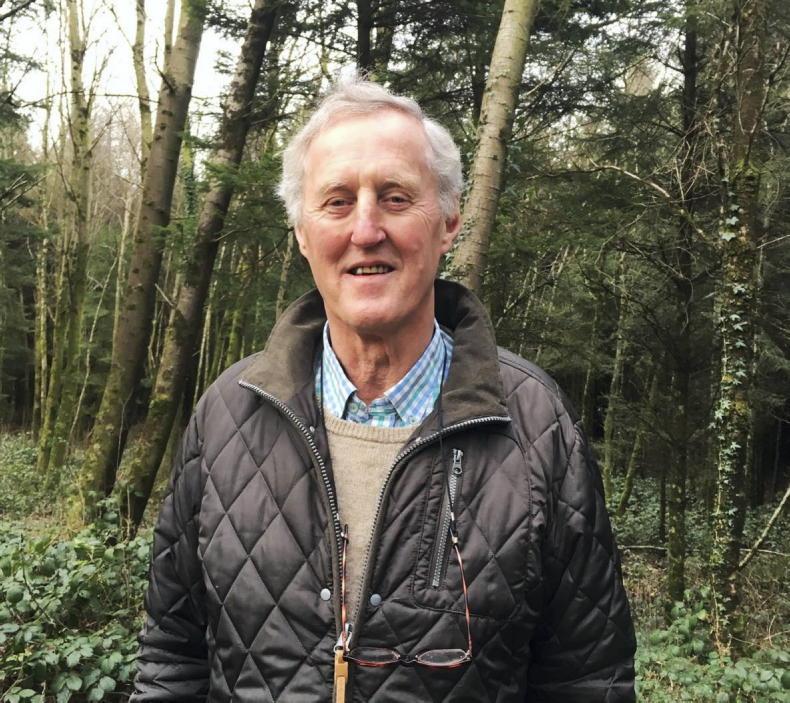We are fortunate in Ireland to experience a climate that minimises the risk of major forest fires. High fire risk regions around the world regularly experience catastrophic forest fires due to prolonged drought periods.
In Ireland, partial drought periods (29 consecutive days with a rainfall averaging less than 0.2mm/day) occur one year in 10, so large-scale fires are rare.
Since records began in 1930, annual fire damage has only exceeded 1,000ha in six years (Figure 1).

In 2017, approximately 1,850ha of forests were destroyed, comprising 200ha of private forest and 1,650ha of Coillte’s estate. This was an exceptional year, with 1,500ha burnt in Coillte’s Cloosh Valley forest alone.
Although the weather is unsettled at the moment, forests are still vulnerable to fire as ground vegetation is still combustible until fresh growth emerges.
The fire risk has been increased as a result of deliberate burning. The legality regarding burning vegetation is clear: “It is an offence to cut, grub, burn or otherwise destroy any vegetation growing on any land not then cultivated between the first day of March and 31st day of August in any year.”
The Department reminds farmers of the consequences of illegal burning, including:
Risk of prosecution.Burnt land is not eligible for Basic Payment and other area-based schemes.Illegal burning can also result in damaging adjoining land which could also be declared ineligible for payment.Fire prevention
There are a few practical steps worth taking to prevent forest fire damage. These will depend on the fire risk, size and type of woodland and location.
For example, low-lying mixed woodlands carry little risk while upland forests are more vulnerable, especially from hill or mountain wildfires.
It is important to have an updated fire plan.
The written fire plan should include contact names and phone numbers of fire brigade, gardaí, helpers, local doctor and a contractor who has a slurry tank to carry water.
In large vulnerable forests, the plan should include maps with locations of access and gathering points, public and forests roads, firelines and water points.
It is important to discuss the fire plan with forest producer groups, neighbours and owners of adjoining forests.
Most forest fires begin outside the forest so forest owners should ensure that fire breaks at least 6m wide are kept vegetation-free on high-fire-risk boundaries.
Forests should be insured against losses by fire, to cover loss of crop revenue, replanting and related costs.
The advice to farmers, other landowners and the public is “be prepared, be vigilant. Stamp out forest fires”. If you see a fire or suspicious activity, report it to the fire and emergency services by calling 999 or 112.
To sell or not to sell your forest?
Vincent Nally of the IFA advises against selling as long-term timber revenue is far more attractive, writes Donal Magner

IFA forestry chair Vincent Nally. \ Finbarr O'Rourke
The advice from Vincent Nally to farmers is “to hold on to their forests and reap the future financial rewards of thinnings and clearfells”.
Nally, chair of the IFA farm forestry committee, encourages farmers to continuously manage their forests to maximise revenue. “The increased interest in purchasing forests, especially by large-scale corporations, demonstrates the value of forests as a long-term investment,” he says.
This is a welcome development for farmers who may wish to cash in their investment, but they should fully research their options and seek independent valuation of their forests, he advises.
“There is still a naivety among some farmers about the value of their forests so current prices offered can understandably tempt growers to cash in their assets. The alternative, more financially rewarding, approach is to realise current and accrued income, especially considering zero interest rates at the moment.”
The recent Irish Farmers Journal supplement on land sales outlined some of the excellent offers being made for forests.
For example, an attractive 20ha crop – 20-25 years age – of top-quality spruce at second thinning stage can realise €300,000 to €400,000.
The owner who opts to continue managing a crop of this scale could receive revenue of €40,000 for two further thinnings and approximately €500,000 from clearfell, amounting to a total tax-free income of €540,000. Even allowing for reforestation expenditure, the owner is financially better off than selling the forest, according to Nally.
This approach requires planning and continuous management as well as patience and perseverance. A thinning licence will be required, necessitating a probable Natura Impact Statement (NIS). Delays of over a year for a felling licence are not unusual.
However, despite numerous obstacles, Nally strongly advises farmers not to sell their forests. “I also urge the Department to change procedures to a single licence system at the establishment stage, to last for the first and second thinning at least,” he says.
Forest owners should
exercise caution before
selling harvesting rights
Irish Forest Owners (IFO) has urged its members to exercise caution before selling the harvesting rights to their forests.
“On today’s prices, the final harvest value of a well-managed quality conifer forest is likely to be in the region of €10,000–€15,000 per acre and we are concerned that many private forest owners may not realise the true value of their asset,” maintains Nicholas Sweetman, chair of the IFO, the representative body for most forest owner groups in Ireland.

Nicholas Sweetman.
“A number of investment companies are seeking to buy the harvesting rights from private forest owners, offering a lump sum up front with annual payments until clearfell,” he says.
“It is of particular concern that these companies are cherry-picking softwood plantations that have recently come out of premium payments and that the owners may not be offered the true value of their forest,” he said.
He points to landowners with semi-mature crops.”They should be cautious of relinquishing the value of their timber mid-way through the life cycle of their trees. They should not become sharecroppers on their own land.”
It is also possible that relinquishing harvesting rights may have unforeseen adverse tax and carbon credit implications in the future, he maintains.
“At present, there is a favourable tax regime for forestry profits and for the transfer of forests to the next generation,” he explains.
The IFO is recommending that forest owners considering offers should get an independent valuation of their forest.
“Forest owners can also benefit from information and support from their forest owners group, as well as independent advice from their local Teagasc forester.”
We are fortunate in Ireland to experience a climate that minimises the risk of major forest fires. High fire risk regions around the world regularly experience catastrophic forest fires due to prolonged drought periods.
In Ireland, partial drought periods (29 consecutive days with a rainfall averaging less than 0.2mm/day) occur one year in 10, so large-scale fires are rare.
Since records began in 1930, annual fire damage has only exceeded 1,000ha in six years (Figure 1).

In 2017, approximately 1,850ha of forests were destroyed, comprising 200ha of private forest and 1,650ha of Coillte’s estate. This was an exceptional year, with 1,500ha burnt in Coillte’s Cloosh Valley forest alone.
Although the weather is unsettled at the moment, forests are still vulnerable to fire as ground vegetation is still combustible until fresh growth emerges.
The fire risk has been increased as a result of deliberate burning. The legality regarding burning vegetation is clear: “It is an offence to cut, grub, burn or otherwise destroy any vegetation growing on any land not then cultivated between the first day of March and 31st day of August in any year.”
The Department reminds farmers of the consequences of illegal burning, including:
Risk of prosecution.Burnt land is not eligible for Basic Payment and other area-based schemes.Illegal burning can also result in damaging adjoining land which could also be declared ineligible for payment.Fire prevention
There are a few practical steps worth taking to prevent forest fire damage. These will depend on the fire risk, size and type of woodland and location.
For example, low-lying mixed woodlands carry little risk while upland forests are more vulnerable, especially from hill or mountain wildfires.
It is important to have an updated fire plan.
The written fire plan should include contact names and phone numbers of fire brigade, gardaí, helpers, local doctor and a contractor who has a slurry tank to carry water.
In large vulnerable forests, the plan should include maps with locations of access and gathering points, public and forests roads, firelines and water points.
It is important to discuss the fire plan with forest producer groups, neighbours and owners of adjoining forests.
Most forest fires begin outside the forest so forest owners should ensure that fire breaks at least 6m wide are kept vegetation-free on high-fire-risk boundaries.
Forests should be insured against losses by fire, to cover loss of crop revenue, replanting and related costs.
The advice to farmers, other landowners and the public is “be prepared, be vigilant. Stamp out forest fires”. If you see a fire or suspicious activity, report it to the fire and emergency services by calling 999 or 112.
To sell or not to sell your forest?
Vincent Nally of the IFA advises against selling as long-term timber revenue is far more attractive, writes Donal Magner

IFA forestry chair Vincent Nally. \ Finbarr O'Rourke
The advice from Vincent Nally to farmers is “to hold on to their forests and reap the future financial rewards of thinnings and clearfells”.
Nally, chair of the IFA farm forestry committee, encourages farmers to continuously manage their forests to maximise revenue. “The increased interest in purchasing forests, especially by large-scale corporations, demonstrates the value of forests as a long-term investment,” he says.
This is a welcome development for farmers who may wish to cash in their investment, but they should fully research their options and seek independent valuation of their forests, he advises.
“There is still a naivety among some farmers about the value of their forests so current prices offered can understandably tempt growers to cash in their assets. The alternative, more financially rewarding, approach is to realise current and accrued income, especially considering zero interest rates at the moment.”
The recent Irish Farmers Journal supplement on land sales outlined some of the excellent offers being made for forests.
For example, an attractive 20ha crop – 20-25 years age – of top-quality spruce at second thinning stage can realise €300,000 to €400,000.
The owner who opts to continue managing a crop of this scale could receive revenue of €40,000 for two further thinnings and approximately €500,000 from clearfell, amounting to a total tax-free income of €540,000. Even allowing for reforestation expenditure, the owner is financially better off than selling the forest, according to Nally.
This approach requires planning and continuous management as well as patience and perseverance. A thinning licence will be required, necessitating a probable Natura Impact Statement (NIS). Delays of over a year for a felling licence are not unusual.
However, despite numerous obstacles, Nally strongly advises farmers not to sell their forests. “I also urge the Department to change procedures to a single licence system at the establishment stage, to last for the first and second thinning at least,” he says.
Forest owners should
exercise caution before
selling harvesting rights
Irish Forest Owners (IFO) has urged its members to exercise caution before selling the harvesting rights to their forests.
“On today’s prices, the final harvest value of a well-managed quality conifer forest is likely to be in the region of €10,000–€15,000 per acre and we are concerned that many private forest owners may not realise the true value of their asset,” maintains Nicholas Sweetman, chair of the IFO, the representative body for most forest owner groups in Ireland.

Nicholas Sweetman.
“A number of investment companies are seeking to buy the harvesting rights from private forest owners, offering a lump sum up front with annual payments until clearfell,” he says.
“It is of particular concern that these companies are cherry-picking softwood plantations that have recently come out of premium payments and that the owners may not be offered the true value of their forest,” he said.
He points to landowners with semi-mature crops.”They should be cautious of relinquishing the value of their timber mid-way through the life cycle of their trees. They should not become sharecroppers on their own land.”
It is also possible that relinquishing harvesting rights may have unforeseen adverse tax and carbon credit implications in the future, he maintains.
“At present, there is a favourable tax regime for forestry profits and for the transfer of forests to the next generation,” he explains.
The IFO is recommending that forest owners considering offers should get an independent valuation of their forest.
“Forest owners can also benefit from information and support from their forest owners group, as well as independent advice from their local Teagasc forester.”









 This is a subscriber-only article
This is a subscriber-only article










SHARING OPTIONS: